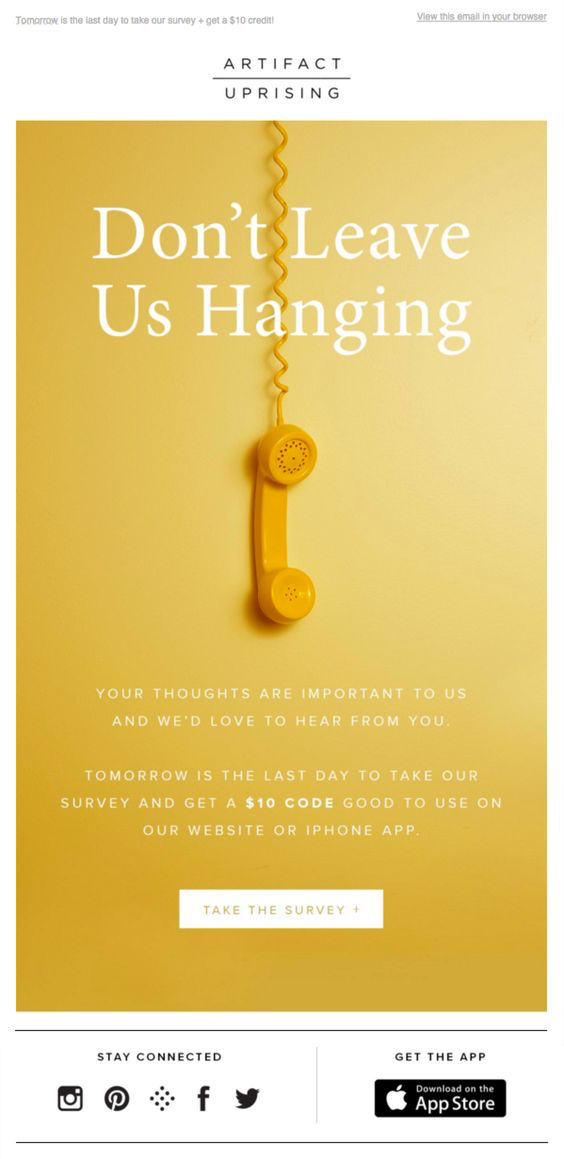Remember when email was a novelty?
If you’re a Generation Zer, you might not. But if you’re a Millennial or older, then you probably recall a time when receiving email was fun.
Our relationship with email has shifted dramatically over the past few decades. As Adrienne La France observed in The Atlantic:
“In the 1990s, AOL would gleefully announce, ‘You’ve got mail!’ Today, Gmail celebrates the opposite: ‘No new mail!’”
The virtual mailbox has become a burden, and for many, a source of daily anxiety. Like salmon swimming upstream, we battle the constant flow into our inbox, and even if we take a break, the current never stops.
Despite the rise of Slack, Hipchat, and other messaging apps, email remains the business world’s most pervasive form of communication.
In fact, the average corporate worker sends and receives 105 emails each day. I myself write at least 100 and send about 50 emails every workday at Jotform.
According to the McKinsey Global Institute, checking and sending email takes up about 28 percent of the average person’s workweek. That translates to 11 hours in a 40-hour week — a potentially serious strain on our productivity.
Email isn’t going anywhere. So instead of fighting the current, we can figure out how to master it. And who better to learn from than email marketers: professionals dedicated to succinct, successful email writing.
I’m going to break down every email into three crucial parts, and explain how to tackle each one. By using the techniques below, hopefully you can increase both your personal and team productivity — without swearing off email altogether.
But first, let’s step back and consider whether to send an email at all.
To send or not to send
That is the question. Or at least it should be, before you even click “compose.”
As it turns out, a significant number of the emails we send aren’t necessary.
Duke University behavioral economist Dan Ariely found that “roughly a third of messages did not clear the bar of needing to be seen at all, and only about a tenth of emails were considered important enough to need to be read within five minutes of receipt” — a figure that should make us all reconsider email notifications.
Sending a superfluous email can do more damage than good, and even undermine your credibility in the eyes of the recipients.
As I’ve shared before, I’m a big proponent of Inbox Zero. To that end, I archive any message that’s irrelevant or doesn’t require a reply. At the same time, I try to be conscientious about every email I send, so I’m not filling my colleagues’ inboxes, either.
There should be an unspoken social contract: I agree to respect your inbox if you agree to respect mine.
Before you draft a new email, consider whether another form of communication would better serve your purpose.

If you anticipate questions, for example, a phone call might be the best move. The same logic applies to personal matters. Phone calls tend to increase our empathy and understanding, as compared to hiding behind our computer screens
One University of Michigan study examined empathy among 72 groups of American college students by comparing students from the ’70s and ’80s with students from the ’90s and 2000s. The researchers found a significant decrease in empathy over time, which correlated with increased use of technology.
“We speculate that one likely contributor to declining empathy is the rising prominence of personal technology and media use in everyday life,” the researchers concluded. “With so much time spent interacting with others online rather than in reality, interpersonal dynamics such as empathy might certainly be altered.”
In short: digital communication makes us less empathetic.
So, if a family or medical issue has come up, it might be better to take the conversation offline.
On the other hand, if you have a quick question or need minor clarification, a messaging app like Slack or a collaboration tool like Basecamp would be both faster and easier.
And beware of committing these all-too-common email faux pas: the late-night email to show you’re burning the midnight oil, gratuitous self-promotional emails, or unnecessarily cc:ing a manager.
While the “cc:” is an appropriate way to keep managers informed of a project’s status, doing so excessively can cause mistrust between colleagues.
At least that’s what Cambridge University professor David De Cremer found in his research on office email traffic.
Contrary to what we might believe, continually copying the manager doesn’t create transparency. Instead, Professor De Cremer says it builds a “culture of fear and low psychological safety.”
“The more often you include a supervisor on emails to co-workers,” he explains, “the less trusted those co-workers feel.”
That’s when our attempts at transparency can ultimately backfire.
If you do decide that an email is necessary, here are three crucial points to consider.
Three parts of a successful email
1. The CTA
In marketing lingo, the CTA, or call-to-action, is the final part of an email. It’s where you tell the email recipient what to do next: subscribe here, shop now, learn more.

You might wonder why I’m starting at the end, but it’s because the CTA is the most important part of any email.
Email marketers care about eye-catching subject lines and great content. But the most important metric is the “click-through” rate: how many people take action after receiving the email. And that depends on the strength of our CTA.
That’s why we should start with the CTA, or any action items, and work backward from there.
Keeping this in mind, consider the end goal of your email. Whether you’re seeking a reply or requesting further action, make sure your desired outcome is loud and clear. And where possible, give suggestions rather than open-ended questions.
For example, rather than:
@Jan: let me know when you can meet
Try:
@Jan: please confirm if Thursday at 11 am works for you
Or, one step further:
@Jan: I’ll book a room for Thursday at 11 am unless you reply otherwise
In terms of formatting, make your CTAs highly visible. Use a separate paragraph and bold, clear fonts.
When there are several action items, separate them with bullet points, and try to limit your action items to two per email. Send new emails for additional action items.
And if you’re addressing multiple recipients, use “@” to direct action items to different people.
Once you’re satisfied with the CTA, it’s time to compose a strong email body.
2. The body
Career experts say that sending long messages is the top mistake people make when writing work emails because it decreases the chance that your email will be read from start to finish.
Effective emails are brief emails. What’s more, 47% percent of all emails are now opened on a mobile device, which increases the need for brevity.
As a rule of thumb (and a courtesy to your recipient’s tired eyes), limit emails to 150 words or less.
If you can’t work within that word count, consider whether another form of communication would be more appropriate, or alternately, draft multiple emails.
Email marketing pros also recommend that we try to create personal connections with our readers. After all, not every work email will be riveting. But you can still insert a little “fluff” — like a personal tidbit — to build rapport and remind your reader that there’s a human on the other end of their computer screen. We’re not robots firing messages back and forth.

Let’s say you’re asking a colleague to generate a monthly report. Without being disingenuous, you can soften the request with a personal touch:
Dear Michael,
Really enjoyed our lunch on Friday. Thanks again for showing us your favorite ramen spot.
I’m writing about the monthly sales report. Please prepare …
You get the idea.
Inserting a bit of human experience can make a dry email more digestible.
3. Subject Line
Last but certainly not least, craft an effective subject line.
In the world of email marketing, studies show that 50 percent of subscribers open an email based on the subject line alone. That line and your name are the first details a recipient sees when scanning their inbox.
So, don’t treat the subject line as an afterthought. Spend a few extra minutes writing an informative, and if possible, creative email subject.
I recently read some great email-writing advice from military veteran and former JP Morgan Chase VP (not to mention bestselling author) Kabir Sehgal.
Not only does he explain how to write with military precision, his piece also puts the power of communication into perspective; if you think your email is urgent, imagine if there’s a war-time mission on the line.
Sehgal recommends using subject line keywords that characterize the nature of the message in ALL CAPS, so a recipient immediately recognizes the purpose of your email.
Common military keywords that could work equally well in the business world include:
- ACTION — Compulsory for the recipient to take some action
- SIGN — Requires the recipient’s signature
- INFO — For informational purposes only. No response or action required
- DECISION — Requires a decision from the recipient
- REQUEST — Seeks permission or approval from the recipient
- COORD — Coordination by or with the recipient is needed
Don’t be afraid to get creative. Mix in questions, idioms, and other engaging copywriting techniques.
For example, rather than
Subject: membership committee meeting
Try:
Subject: REQUEST: Will you lead the membership committee meeting this Friday?
At a glance, the second subject line instantly tells the reader what you want. That means you’ll probably get a faster reply — especially when only a short answer is required.
Learn to love email again
I love email, and I can’t imagine working without it.
At Jotform, email enables our 130-people team to communicate seamlessly between offices (while navigating the 11-hour time difference).
Though email has its drawbacks, like that tiny surge of anxiety we feel with every notification, it can also make us infinitely more productive — especially if we’re deliberate about each message we compose.
By thinking like an email marketing pro, we can save time for ourselves and our recipients, and accomplish the core purpose of each message.







































































Send Comment: